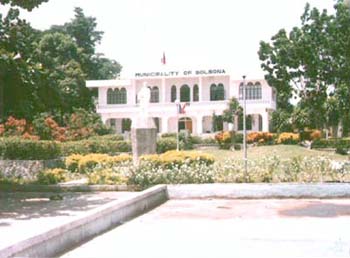

| Municipality of SOLSONA |

Solsona the emerging growth center at the foot of the Cordillera ranges, lies on the south bank of labogaon River and sandwiched by the Gasgas River. It is some 30 kilometers east of Laoag City, about 514 kilometer from "00" kilometrage. It can be reached by land transportation from all directions. The Solsona-Kabugao-Kalinga Apayao road is now open. Solsona has an area of about 140 square spread over residential, commercial, industries, agricultural, religious, educational and open spaces. Solsona is composed of 22 barangays, 2 comprise the poblacion, the rest comprise the rural areas. It is one of towns endowed with exquisite and vast natural resources. The mountain ranges command the view of the daily rising of the sun. This gave its name "Solsona" it being the "Zone of the Rising Sun" which to the Spaniards is "Zona del Sol". Solsona after all, is coined from the Spanish phrase Zone del Sol. This town is so appropriately named as its vista of a beautiful scenery as the morning sun majestically rises from the Cordillera ranges. Due to two big floods which visited the locality, the development and progress of the municipality was hindered and which prompted the people in this town to settle in a higher place. On account of the floods, the income of this new municipality became so meager and insufficient to support the new governmental operations of the town. This necessitated the incorporation of the administrative affairs of Solsona to that of the town of Dingras. It did not take long, however, for the town and its people to recover from the catastrophe so in 1910, Solsona again became administratively independent with its 22 barangays contributing their share in the town's economic development and progress. Solsona occupies a land area of around 140 square miles. It has an irrigated agricultural land area of about 3,572 hectares without irrigation, 112 hectares, developed forest area of about 6,921 hectares and some 7,612 hectares of virgin forest lands. Solsona is envisioned to become on the most progressive towns of the province. The completion of the 7th longest bridge in the Philippines now links Solsona with the other growth centers of the province. Contributing also to the development of this town is the construction of the Ilocos Norte-Kabugao-Kalinga Apayao National Highway. The multi-function Palsiguan Multi-Purpose project is very unique and this town is very fortunate to have one like this. The soil is very fertile and water is abundant. This is the reason why most of the people are engaged in farming. The principal crops grown are rice, corn, sugarcane and vegetables. The grassy lands bordering the Cordillera are ideal places for herding. Weaving is very important industry. Most of the clothes of the people are made locally and the best buyers of these in Solsona are the Itnegs. The weavers even barter what they weave with tobacco, while some are exported. Cheese is made in barangays Mabilog and barangay Darasdas through a method that is still crude. However, if this properly developed, the place would be able to supply the province with his native dairy product. A good quality of keso (cheese) is made in Barangay Manalpac and Nagpatpatan. The presence of cattle and Carabaos grassy lands an ideal climate make Solsona a good location for a dairy farm. The grid stone is found in barangays of Solsona. If properly exploited, it could be a good source of income for the people. Gold deposits are abundant. However, the town still lacks the appropriate facilities to tap these natural resources. The town was progressed economically, so that from a fourth class municipality, it has became a third class town. |





